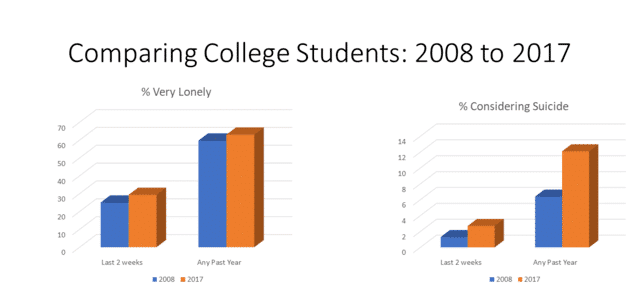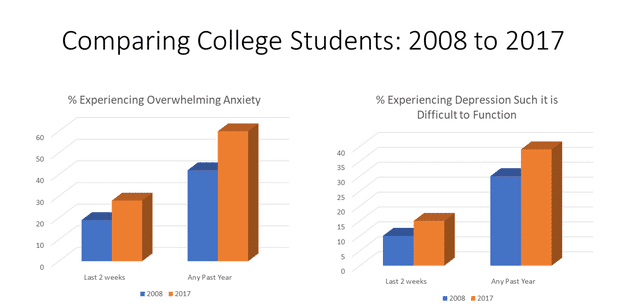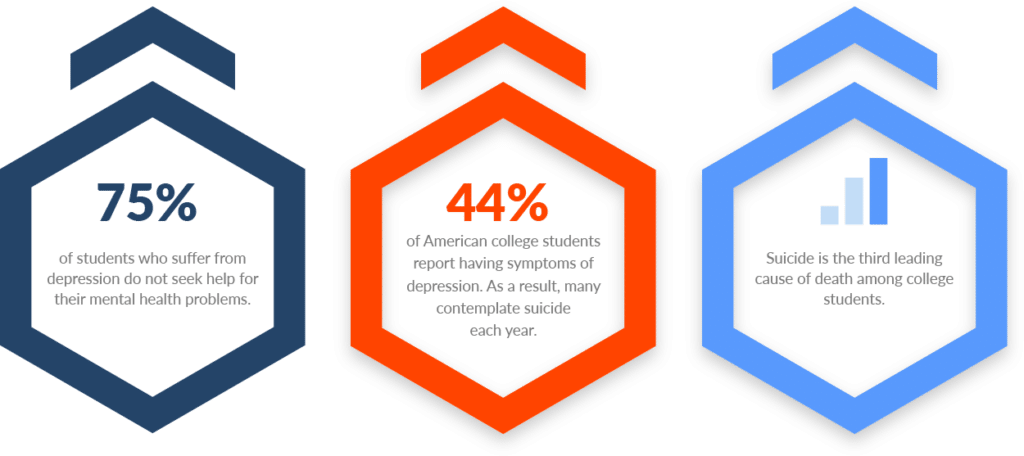How to Manage Back-to-School Mental Health and Wellbeing
When we think about mental health as it relates to getting the kids back to school, most of us tend to think of the mental health of the parents first. After all, parents of young children often worry about whether their child will quickly adjust to an entirely new routine, make new friends, and succeed. Parents of high school kids stress about the influence of peers and whether they’ll get the grades that will prepare them for college. Lastly, parents of college students have to cope with empty nest syndrome, which for some could be as debilitating as grieving the loss of a loved one.
However, there’s another critical aspect of back-to-school mental health — that of the student. There are many techniques parents, and teachers use during the pre-kindergarten and elementary years to help students adapt to a new school year, and by the time kids reach high school age, they can usually get over the back-to-school blues reasonably quickly.
For first-time college students, though, mental health challenges can be somewhat overwhelming.
The eye-opening reality of college students’ mental health
A 2018 study of 14,000 students published in an American Psychological Association journal found that more than one-third of first-year college students worldwide reported “symptoms consistent with a diagnosable mental health disorder.” Thirty-five percent of respondents who attended 19 colleges across eight industrialized countries were found to have symptoms of at least one mental health disorder. The most common was a major depressive disorder, followed by Generalized Anxiety Disorder (GAD).
This recent study is not the first to recognize the problems surrounding the mental health of first-time college students. In 2014, psychology professor Dr. Gregg Henriques shared in Psychology Today the scope of what he called an “emerging” mental health epidemic. “It is neither an exaggeration nor is it alarmist to claim that there is a mental health crisis facing America’s college students,” wrote Henriques. “Evidence suggests that this group has greater levels of stress and psychopathology than any time in the nation’s history.”
Dr. Henriques reported “skyrocketing” rates of anxiety and depression among college students. Comparing a mental health study from 2004 to a similar survey in 2012, he found that the number of female college freshmen who reported frequently feeling overwhelmed was at its highest point in 2012 at 40.5 percent, and the fewest number of first-year students in the history of the survey described themselves as emotionally healthy. Dr. Henriques cited additional studies that revealed the suicide rate among young adults has tripled since the 1950s and is now the second most common cause of death among college students. Eating disorders and learning disabilities have also increased significantly.
In a 2018 update on the crisis, he followed up on his earlier report with new statistics. “In the 1980s, at any given point, perhaps one in 10 college students could be readily characterized as needing/wanting/using some form of mental health treatment,” said Dr. Henriques. “Now that number is one in three, with trend lines rising.”
Causes of mental health disorders in college students
Many first-time college students will relish all that their first year will provide. This typically includes a whirlwind of exciting events, newfound freedom, and new adult-like experiences. For others, though, the entire situation can be quite overwhelming.
Just think about all the changes first-year students must endure. In three short months, they’ve gone from being a high school senior living under their parents’ roofs and within their rules to being nearly wholly independent. Some are hundreds or thousands of miles away from home, adapting to a new geographical community, and having to forge brand-new relationships with strangers. These new acquaintances and friends can be highly influential, and may directly or indirectly influence or pressure the student to do things that they usually wouldn’t or perhaps never have done. They’ll often do these things to experiment or to fit in.
Most aspects of their lives are new: new professors, new classes, new expectations, and new responsibilities. They’ve traded their comfortable, broken-in childhood bedroom for a semi-functional dorm they’re sharing with one to three strangers. No one is making sure they eat well, or they get up on time. Familiar patterns and routines are in the past, and many students feel they have no one around who knows them well enough to understand what they’re going through.
A 2013 study in College Quarterly entitled “A Suffering Generation” offers six scientifically-based explanations for the rise of mental health symptoms in North American college students. These include:
- Academic pressure
- Financial burden
- Accessibility
- Male-to-female ratio
- Technology
- Lifestyle
The article’s author, Alicia Kruisselbrink Flatt, explains that pressure to succeed academically comes from the elevated expectations of “hovering helicopter parents,” a competitive economic environment, and inflated grades at the high school level. The emotional and mental pressures to please parents, compete with other job-seeking students, and meet or exceed high school GPAs can lead to anxiety, depression, and even thoughts of suicide. Ms. Flatt writes that when these “high expectations are met with a disappointing reality, students are left in a panic, and in some cases, an identity crisis.” She adds that in some cases, students have been “pressured to achieve, but they have never been taught how to fail.”
Rising tuition rates, looming student debt, and the need to work while attending university can all place a financial burden on first-year college students. Although those students with the highest-income parents, those earning scholarships, or the rapidly-declining number who qualify for financial grants may enjoy a financially stress-free college experience, most do not. Sallie Mae, a national student funding and loan program, estimates that in the 2018-2019 school year families spent an average of $26,226 on college. Forty-three percent of costs were covered by family savings and income, 31 percent was covered by scholarships and grants, 24 percent was covered by borrowing, and 2 percent was covered by friends and family, according to Sallie Mae. Ms. Flatt cites several studies that found students with high debt levels routinely experienced mental health disorders and lower academic success.
Accessibility, the third cause of the college mental health crisis, according to Ms. Flatt, results from the fact that “North American post-secondary education has shifted from elite to mass education.” This has led to an increase in students from socio-economically disadvantaged groups who may be at higher risk for mental health disorders. Additionally, an increasingly racially diverse generation of millennials has put additional pressures on college counselors to understand patterns of mental illness in different cultures and diverse socioeconomic backgrounds.
The World Health Organization has found that depressive disorders account for close to 41.9 percent of the disability due to neuropsychiatric disorders among women compared to 29.3 percent among men. It also reports that depression, anxiety, psychological distress, sexual violence, domestic violence, and escalating rates of substance use affect women more than men. As of the 2018 fall semester, 11.2 million newly-enrolled students were female, while only 8.7 million were male.
Although technology is purportedly designed to make life easier, a 2019 report in Frontiers in Psychiatry found several adverse effects of personal computing technology use on the mental health of college students. These include fear of missing out (FOMO), hyper-connectivity with peers, peer comparison, decreased face-to-face social interactions, impairment of social skill development, and decreased inhibition of antisocial behavior. While both Ms. Flatt and the Frontiers article also cite positive mental health benefits from technology, such as access to online mental health programs, Ms. Flatt calls for moderation in technology use and believes that students should strive for a healthy balance of digital media and real-world experiences.
An additional element affecting college students’ mental health, according to Ms. Flatt, is lifestyle choices and new habits. Weight gain is typical among first-time college kids. Most everyone has heard the expression “freshman fifteen,” referring to the extra pounds new students will pack on due to new eating habits, stress, and lack of activity. Some students experience serious eating-related issues, such as bulimia or anorexia. Over-consumption of alcohol and risky sexual behaviors are also correlated with low self-esteem, guilt, and depression, especially among women. Colleges and the psychiatric community alike are exploring opportunities for intervention to help students “approach alcohol intelligently,” but the problem persists.
A more recent, yet related, problem is the abuse of controlled drugs like Adderall, which is prescribed to people dealing with attention-related disorders. Often called “study drugs,” this medication and similar ones reportedly gives students “almost superhuman focus and concentration.” With this reputation, perhaps it’s no surprise that these drugs are readily available on college campuses. Students with prescriptions will share their pills with their friends or sell them. Non-medical use of these drugs rose 67 percent from 2006 to 2011, as did emergency room visits attributed to Adderall.
A plethora of studies has been launched to explore and address the mental health epidemic among college students. All recommend that college students struggling with adjusting to college or a mental health concern seek help from an on-campus resource, such as the counseling center or student health services, or an off-campus resource, such as local mental health professional. Our practice, the Therapy Group of DC, welcomes clients of all ages and will personalize a confidential treatment to college students’ specific needs while accommodating their demanding school schedule. Most of us have had extensive experience and training working with university students.
Recognizing the symptoms of students’ mental health issues
If you’re a college student or a friend, professor, or parent of one, you should be aware of how to recognize the signs and symptoms of mental health disorders, especially during the transition to college life.
The National Alliance on Mental Illness has identified 10 common warning signs that a college student or young adult may be experiencing a mental health condition. These include the following:
- Feeling very sad or withdrawn for more than two weeks
- Attempting to harm or kill oneself or making plans to do so
- Severe out-of-control, risk-taking behaviors
- Sudden, overwhelming fear for no reason
- Not eating, throwing up, or using laxatives to lose weight; significant weight loss or weight gain
- Seeing, hearing, or believing things that are not real
- Abusing drugs or alcohol
- Drastic changes in mood, behavior, personality, or sleeping habits
- Extreme difficulty in concentrating or staying still
- Intense worries or fears that get in the way of daily activities
While one of these symptoms can be enough to cause alarm, having several of them can be a strong indication that a student needs immediate intervention from a mental health professional. Additionally, students may experience some of these symptoms from time to time, such as concentration issues while cramming for a test or feeling sad after the break-up of a relationship. It’s when these symptoms become intense, repetitive, long-lasting, or drastic that steps should be taken to address their mental health concerns.
With that said, however, the two most common struggles among college students are depression and anxiety. They have their own sets of symptoms that require attention and can be addressed by a mental health professional. Mild depression can be a regular part of the college experience and is often readily addressed. According to CollegeStats, common symptoms of depression can include a loss of interest in social activities, sleeplessness, fatigue, loss of motivation, feelings of sadness or helplessness, and trouble concentrating. When depression interferes with life and makes it challenging to study, work, rest, and eat, it may be time to take action.
The same caveat applies to anxiety: Moments of anxiousness can occur when meeting new people in college or studying for a test. Eighty percent of students report that they feel stress daily, but when that stress turns into anxiety, intervention by a mental health professional is recommended.
Symptoms of anxiety can include constant fear, frequent headaches, sweating, feeling dizzy often, shortness of breath, always feeling stressed or irritated, irregular heartbeat, or frequent stomachaches. Symptoms of an anxiety disorder such as social anxiety, generalized anxiety disorder, or panic disorder can feel even worse. Constant worry, fear of social gatherings, significant interference with school performance, or irrational fears could indicate a severe anxiety condition.
Coping with back-to-school mental health and achieving emotional wellbeing
With any of the conditions discussed here, seeking help from a licensed counselor or mental health professional is an excellent decision, even if symptoms don’t seem severe. There are also simple strategies college students can use to cope when feeling anxious or stressed. The Anxiety and Depression Association of America cites the following tips:
- Take a time-out. Practice yoga, listen to music, meditate, or get a massage
- Eat well-balanced meals. Don’t skip meals and keep healthy snacks on hand
- Limit alcohol and caffeine. These can aggravate anxiety and trigger panic attacks
- Get enough sleep. Your body needs rest when you’re stressed
- Exercise daily to feel good and maintain your health
- Take deep breaths or count to 10 slowly, then repeat the process
- Do your best instead of aiming for perfection
- Get involved. Volunteer and create a support network
- Welcome humor — a good laugh goes a long way
Anyone who interacts with a college student who is struggling to adjust or is displaying symptoms of depression, anxiety, or other mental health issues can help them cope by encouraging the actions above and by also offering a compassionate, non-judgmental listening ear. Ask them to take a walk with you, invite them out for a healthy meal, or introduce them to community volunteer organizations. If you’re trying to help them via long-distance, encourage them to practice these tips. Reiterate that their best is good enough or tell them a joke that promotes a good belly laugh.
If you’re worried that a college student is contemplating suicide, more immediate action is required. The ADAA recommends five steps: Ask them if they are considering killing themselves, keep them safe, listen carefully to what they’re thinking or feeling, help them connect to a suicide hotline (the National Suicide Prevention Hotline number is 1-800-273-TALK) or mental health professional, and stay in touch with them when the crisis passes.
Help your college student get help
Perhaps the most alarming statistic from the 2018 APA study is that only 15 to 20 percent of the students planned to seek assistance from a mental health professional. The study’s researchers also expressed concern about university-based counseling centers being “overtaxed” and recommended that students seek help from local mental health resources.
Collegestats.org found that specifically, 75 percent of students who suffer from depression do not seek help for their mental health problems. However, college counseling services have reported that 66.8 percent of college students who do work with a mental health professional believe that counseling helped them with their academic performance, and 65.2 percent believe counseling helped them stay in school.
Thankfully, reaching out for support from a mental health professional or licensed counselor is considered less taboo. In fact, 42.6 percent of the 46.6 million U.S. adults with a mental condition received mental health services in 2017. Help is more accessible than ever for college students, with on-campus and online sources as well as local, community therapists. To schedule your personalized consultation with the best therapists in DC, use our intelligent mental health matching and scheduling system today.




